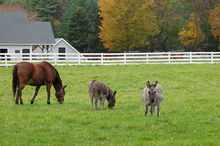With spring time comes warm sunny days and an abundance of lush, green pasture, as well as an increased probability of laminitis and colic in horses, if not managed properly.

Horse enjoying spring pasture
The switch from hay to pasture can represent a dramatic change in the horse's overall diet, with the potential to cause digestive upset that may lead to colic or laminitis.
Fresh pasture can be a great source of relatively inexpensive nutrition for horses. a well-managed pasture in which measures have been taken to fertilize, control weeds, and prevent over-grazing can cost as much as one-third less than feeding hay. access to pasture also provides horses with an opportunity to partake in natural grazing behaviors.
However, fresh pasture can also pose a few problems. The switch from hay to pasture can represent a relatively dramatic change in the horse's overall diet, with the potential to cause digestive upset. The nutrient composition of hay and pasture can be quite different, particularly in terms of non-structural carbohydrate content.
Sudden increases in intake of nonstructural carbohydrates may lead to increased incidence of laminitis and colic. Consequently, it's important to transition horses slowly from hay to pasture.
Start by allowing horses access to pasture for 30-45 minutes a day for the first few days and gradually increase the duration of their grazing time over the course of 2-3 weeks. one way of preventing horses from gorging themselves when turned out to pasture is to feed them hay first; this way theyâre already full and physically limited to how much grass they can consume.
Extra precautions should be taken with horses that are particularly sensitive to nsC levelsincluding those that have previously battled laminitis, or deal with insulin resistance, Cushingâs disease, polysaccharide storage myopathy, or equine metabolic syndrome).
For these horses, it is recommended to eliminate grazing time altogether or reduce grazing to a few hours per day until pasture forages have matured and nsC content has decreased.
Unfortunately, both laminitis and colic have been associated with the lush, spring pasture horse owners look forward to each year. Consider your current management strategies and the horses under your care. Do you need to make adjustments to your management program to help prevent these potentially devastating conditions in your horser?
